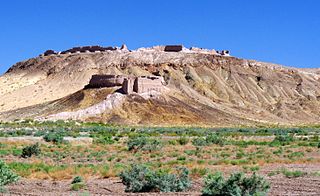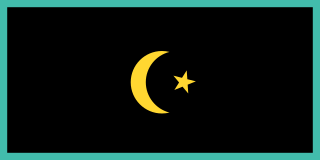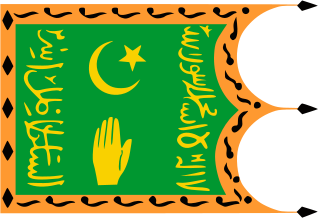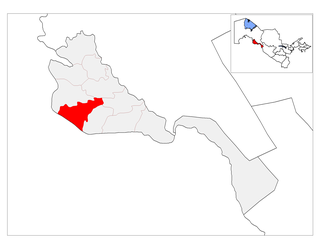Khiva is a city in Xorazm Region, Uzbekistan.
Khiva may also refer to:
- FK Khiva, a football club based in Khiva
- Khanate of Khiva, a former Central Asian polity
- Khiva District, an Uzbek district encompassing Khiva
Khiva is a city in Xorazm Region, Uzbekistan.
Khiva may also refer to:

Uzbekistan is a landlocked country in Central Asia. It is itself surrounded by five landlocked countries: Kazakhstan to the north; Kyrgyzstan to the northeast; Tajikistan to the southeast; Afghanistan to the south, Turkmenistan to the south-west. Its capital and largest city is Tashkent. Uzbekistan is part of the Turkic languages world, as well as a member of the Organization of Turkic States. While the Uzbek language is the majority spoken language in Uzbekistan, Russian is widely used as an inter-ethnic tongue and in government. Islam is the majority religion in Uzbekistan, most Uzbeks being non-denominational Muslims. In ancient times it largely overlapped with the region known as Sogdia, and also with Bactria.

Khiva is a district-level city of approximately 93,000 people in Xorazm Region, Uzbekistan. According to archaeological data, the city was established around 1500 years ago. It is the former capital of Khwarezmia, the Khanate of Khiva, and the Khorezm People's Soviet Republic. Itchan Kala in Khiva was the first site in Uzbekistan to be inscribed in the World Heritage List (1991). The astronomer, historian and polymath, Al-Biruni was born in either Khiva or the nearby city of Kath.

Russian Turkestan was the western part of Turkestan within the Russian Empire’s Central Asian territories, and was administered as a Krai or Governor-Generalship. It comprised the oasis region to the south of the Kazakh Steppe, but not the protectorates of the Emirate of Bukhara and the Khanate of Khiva.

This article discusses the administrative-territorial division of the Republic of Uzbekistan. The Article 68 of the constitution of Uzbekistan defines:
The Republic of Uzbekistan shall consist of regions, districts, cities, towns, settlements, kishlaks and auls (villages) in Uzbekistan and the Republic of Karakalpakstan.

Urgench is a district-level city in western Uzbekistan. It is the capital of Xorazm Region. The estimated population of Urgench in 2021 was 145,000, an increase from 139,100 in 1999. It lies on the Amu Darya River and the Shavat canal. The city is situated 450 km (280 mi) west of Bukhara across the Kyzylkum Desert. The history of the city goes back to the second half of the 19th century. The city should not be confused with the similarly named city of Konye-Urgench in Turkmenistan. The city of Old Urgench was left after the Amu Darya river changed its course in the 16th century, leaving the old town without water. New Urgench was founded by Russians in the second half of the 19th century at the site of a little trade station of the Khanate of Khiva.

Khorazm Region (Uzbek: Xorazm viloyati, Хоразм вилояти, خارەزم ۋىلايەتى, is a viloyat of Uzbekistan located in the northwest of the country in the lower reaches of the Amu Darya River. It borders with Turkmenistan, Karakalpakstan, and Bukhara Region. It covers an area of 6,050 square kilometres. The population is estimated 1,893,300, with 67% living in rural areas. The capital is Urgench. Other major towns include Xonqa, Khiva, Shovot, and Pitnak.

The Khanate of Khiva was a Central Asian polity that existed in the historical region of Khwarezm in Central Asia from 1511 to 1920, except for a period of Afsharid occupation by Nader Shah between 1740 and 1746. Centred in the irrigated plains of the lower Amu Darya, south of the Aral Sea, with the capital in the city of Khiva, the country was ruled by a Turco-Mongol tribe, the Khongirads, who came from Astrakhan. It covered present western Uzbekistan, southwestern Kazakhstan and much of Turkmenistan before Russian arrival at the second half of the 19th century.

The Emirate of Bukhara was a Muslim polity in Central Asia that existed from 1785 to 1920 in what is modern-day Uzbekistan, Tajikistan, Turkmenistan and Kazakhstan. It occupied the land between the Amu Darya and Syr Darya rivers, known formerly as Transoxiana. Its core territory was the fertile land along the lower Zarafshon river, and its urban centres were the ancient cities of Samarqand and the emirate's capital, Bukhara. It was contemporaneous with the Khanate of Khiva to the west, in Khwarazm, and the Khanate of Kokand to the east, in Fergana. In 1920, it ended with the establishment of the Bukharan People's Soviet Republic.
Suzak is a village in Jalal-Abad Region, Kyrgyzstan. Its population was 30,534 in 2021. It is the administrative seat of Suzak District.
Chala is an Uzbek term meaning "neither this nor that," referring to Bukharan Jews who were coerced into converting to Islam from the late eighteenth century onwards. In response, these Chala Jews outwardly practiced Islam, but secretly retained their Jewish traditions. These crypto-Jews married among themselves and lived in their own separate neighborhoods that bordered on existing Jewish neighborhoods. The Chala Jews carry a very similar story to the Dönmeh and to the Marranos of Spain.

Ak Mosque is a 19th century mosque in Khiva, Uzbekistan. It stands in Itchan Kala, the walled old city of Khiva, which is a World Heritage Site. It was built between 1838 and 1842 on older foundations. It consists of a square, domed room, surrounded on three sides by a portico (iwan). Its total size is 25.5 x 13.5 m.

Khiva District is a district of Xorazm Region in Uzbekistan. The capital lies at the city Khiva, itself not part of the district. It has an area of 430 km2 (170 sq mi) and it had 147,400 inhabitants in 2021. The district consists of 6 urban-type settlements and 9 rural communities.
Gurlan is a town and seat of Gurlan District in Xorazm Region in Uzbekistan. It is located near the border with Turkmenistan in western Uzbekistan, 42 kilometres (26 mi) north-west of Urgench, north of Shovot, and south of the Amu Darya river. Gurlen is a major centre for cotton production, and rice and yams are also significant other crops.

Photography in Uzbekistan started developing after 1882, when a Volga German photographer and schoolteacher named Wilhelm Penner moved to Khiva as a part of the Russian Mennonite migration to Central Asia led by Claas Epp, Jr. After his arrival in the Khanate of Khiva, Penner shared his photography skills with a local student Khudaibergen Devanov, who later became the founder of Uzbek photography.

The Yomut or Yomud is a Turkmen tribe that lives in Western and Central Asia, including Gorgan, Iran; Turkmenbashi, Turkmenistan; the eastern Caspian shores; Khiva, Uzbekistan; and Dashoguz, Turkmenistan.
The 2013 Uzbekistan Cup was the 21st season of the annual Uzbek football Cup competition. The Cup draw was held on February 25, 2013 in Tashkent.

"Asrlar Sadosi" is a festival of traditional Uzbek culture which attracts tens of thousands of local and overseas tourists every year and presents all the diversity of the national traditions and customs, handicrafts and cuisine, unique oral and non-material heritage. Asrlar Sadosi has been annually organised by The Fund Forum of Culture and Arts of Uzbekistan since 2008, in association with UNESCO since 2009.

During the mid-eighteenth century the Afsharid empire of Nader Shah embarked upon the conquest and annexation of the Khanates of Bukhara and Khiva. The initial engagements were fought in the late 1730s by Nader Shah's son and viceroy Reza Qoli Mirza who gained a few notable victories in this theatre while Nader was still invading India to the south. Reza Qoli's invasions of Khiva angered Ilbars Khan, the leader of Khiva. When Ilbars threatened to make a counter-attack Nader ordered hostilities to cease despite his son's successes and later returned victoriously from Delhi to embark on a decisive campaign himself.
The architecture of Uzbekistan is noted for its originality. Many consider Uzbekistan’s architecture to be notable despite the changing economic conditions, technological advances, demographic fluctuations, and cultural shifts that the country has experienced.

High speed rail in Uzbekistan currently consists of 600 km of track and services using Talgo 250 equipment, branded Afrosiyob by operator Uzbekistan Railways, on upgraded conventional lines. All HSR lines have been built using upgraded lines on Russian gauge. Other regional railways exist.